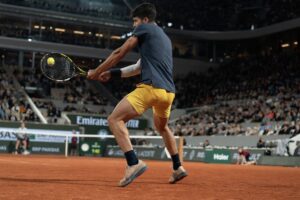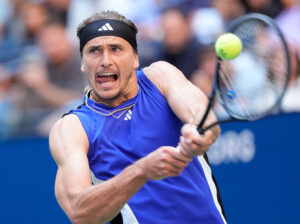Is Wimbledon playing slower than usual?
Wimbledon will see the men’s final that everyone (mostly) expected 13 days ago contested on Sunday, whilst two stars of the women’s game in Simona Halep and Serena Williams reached the final, with the Romanian claiming a surprisingly swift 6-2 6-2 victory. The tournament officials at the All England club can, therefore, be satisfied with the conditions that they have created, which have allowed the best players to play good tennis and go deep into the tournament.
However, it is fair to say that there has been a general, though not universal, consensus the courts at the Championships are playing slower than in previous years. Finalist Roger Federer made a point of describing the conditions as slower than he would usually expect at Wimbledon, although this could be read as someone with influence who wants fast conditions subtly making a point to the “powers-that-be” at the All England Club. Rafael Nadal was the main advocate in response saying that conditions were the same, but would he not have wanted to see slower conditions to help him in his quest for back-to-back slams?
The Federer-Nadal match we have all just savored certainly showed that different playing styles can be successful on the grass courts, although in the end Federer, with his purer grass-court game, found his way through his great rival reasonably comfortably. But does this mean that Nadal was right all along and that the courts, or at least Centre Court, is still as quick as you would expect a grass court to be?
Here comes the Maths
Perhaps the most useful statistic to assess court speed is the hold percentage across the tournament. Usually the higher the hold percentage the quicker the court. This measure is especially accurate across a Grand Slam as there is a bigger sample due to the number of matches played and a more diverse group of players across the draw. This is important, as often on the tour, when the surface is quick, the draw is often made up of players who know that their big serving, big groundstroke game is going to get them wins which skews the data.
Taking this measure then and applying it to Wimbledon 2019, including only the singles matches from the main draw, (with the exception of the two finals), the men have held 82.2% of all service games, whilst the women have held 68.5% of the time in the main draw. But these figures mean next to nothing in isolation, so below are tables to show how these figures fit into recent historical context.
| Men | Hold % | Champion |
| 2019 | 82.2 | Federer or Djokovic |
| 2018 | 83.1 | Djokovic |
| 2017 | 83.3 | Federer |
| 2016 | 82.6 | Murray |
| 2015 | 84.3 | Djokovic |
| 2014 | 84.8 | Djokovic |
| 2013 | 83.7 | Murray |
| Women | Hold % | Champion |
| 2019 | 68.5 | Halep |
| 2018 | 68.0 | Kerber |
| 2017 | 70.5 | Muguruza |
| 2016 | 69.6 | Serena Williams |
| 2015 | 70.1 | Serena Williams |
| 2014 | 69.7 | Kvitova |
| 2013 | 68.4 | Bartoli |
What does it all mean?
It is immediately clear that the hold percentage in this year’s tournament is the lowest it has been since at least 2013, lending credence to the commonly held opinion that the courts are playing slower than usual. However, the difference is fairly negligible, 1.1% lower than last year and 3.1% lower than the peak year of 2014, One would expect the top players to be able to cope well with that minor difference.
In fact, looking at the data from the women’s draw in isolation, one can see that 2019 does not provide the lowest hold serve percentage score. That “honor” goes to 2018, last year, where the hold percentage was 68%. Therefore, this year’s hold percentage is 0.5% higher, though still on the low side, having been above 70% in 2017 and 2015.
So, both sides of the argument have some backing in the numbers, but it does appear as though the Wimbledon courts are generally slower than they have been in the past. Wimbledon have made no changes to the preparation of the courts in over a decade, so the explanation must lie elsewhere. But whether it is to be found in weather conditions, ball speed or just a general serving malaise (the likes of Karlovic, Isner, Anderson and Cilic all made early exits this year though none had the ideal preparation) is as yet unclear.
How will this affect the Men’s final?
So far, Djokovic’s best performances at Championships have come when the courts have been playing at their fastest. Quick courts allow him to turn the tables on his opponent in rallies, and also help him from the line, where his accuracy helps make up for a lack of outright power. Federer also prefers faster conditions, performing well year after year in Halle, which is one of the fastest tournaments of the year on the ATP Tour.
Ultimately, however, the speed of the court is unlikely to be a decisive factor in the final itself, but it could slightly favour Djokovic’s more defensive game, denying Federer the opportunity to rush the Serbian or hit through him. Regardless, the All England Club remains one of tennis’ most magnificent settings and, as ever, the courts have stood up very well to the demands of holding a Grand Slam tournament on grass courts.
Main photo:
Embed from Getty Images






